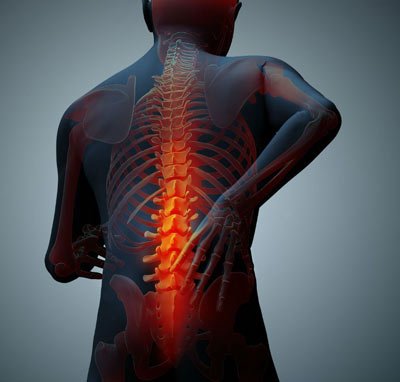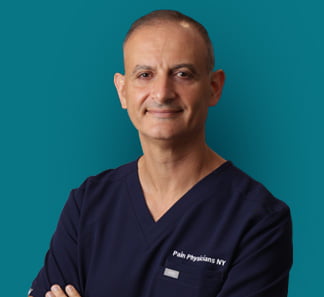Back injury and back pain are leading causes of missed work, disability claims and pain management clinic visits. Up to 80 percent of all adults experience low back pain at some point. If you hurt your back, visit the top back pain doctors in Manhattan at New York pain management. They specialize in lower back, mid-back and upper back injury treatments. Whether your back injury pain is the result of normal aging, poor mechanics or trauma, you’ll find many treatment options to fit your lifestyle and injury concerns.
Back pain can be acute, meaning it lasts six weeks or less, or it can be chronic, meaning it lasts three months or longer. One of the frustrating aspects of back injury treatment is the difficulty in identifying an exact cause, which is why it pays to rely on the best New York back injury center. Some common culprits of back injuries include:
- Bulging or ruptured discs
- Sciatica or pinched nerves that cause weakness, numbness, and tingling to run down the backs of your leg
- A pulled muscle or ligament strain from repeated lifting or awkward motions
- Radiculopathy or the inflammation and compression of a spinal nerve root
- Osteoarthritis that can include the narrowing of the space around the spinal cord
- Spondylolisthesis, a condition that causes the vertebrae of your lower spine to slip out of place
- Skeletal irregularities such as scoliosis or a curvature in the spine
- Osteoporosis or the weakening of the bones that make up your spine
- Trauma due to falls, accidents, collisions or blows
You may be at a higher risk for a back injury if you:

- Are older than 35 or 40
- Don’t exercise regularly
- Are pregnant
- Are obese
- Have a disease such as arthritis or cancer
- Have been diagnosed with osteoporosis
- Regularly lift heavy items improperly
- Live a primarily sedentary lifestyle
- Suffer from depression or anxiety
- Smoke cigarettes
- Have a personal or family history of steroid use, cancer or excessive drug or alcohol use
Symptoms Requiring Back Injury Treatment
Back injury symptoms may develop slowly over time or occur suddenly. Whether because of gradual wear-and-tear or from a traumatic injury, certain common characteristics occur. Tell your injury doctor in New York if you experience a:
- Shooting or stabbing pain anywhere along your spine or down one or both arms or legs
- Muscle ache that’s dull, but constant
- Pain that intensifies with bending, walking, lifting or standing
- Pain that often improves when reclining with your feet elevated
Don’t wait to call on an injury doctor near you if you require back injury treatment because you’re experiencing:
- Severe lower back injury pain that doesn’t improve with rest
- Sudden bowel or bladder problems
- A fever along with the back pain
- Pain that includes one or both of your legs or discomfort that spreads below your knees
- An unexplained, noticeable weight loss
- Pain accompanied by tingling, numbness, or weakness in one or both legs or arms
Diagnosis and Treatment Options
Back pain specialist in Midtown conducts a physical exam to determine your range of mobility and the exact location and symptoms of your pain. He conducts a detailed medical history to rule out possible contributing or originating conditions. Your best rated pain management doctor may also order:
- Blood tests to rule out infections
- X-rays, MRI or CT to look for structural abnormalities
- Abone scan to test for weakening bone conditions
- Nerve studies, such as an electromyography or EMG
Low back injury treatment, mid-back injury treatment and upper back injury treatment begins with the most conservative and least invasive methods first. Proper rest, heat or ice, gentle stretching, light activity such as walking, and anti-inflammatories often resolve minor-to-moderate back injury concerns. If your pain worsens or continues after several weeks, other options include:
- Medications, such as muscle relaxants, anti-seizure drugs, topical pain relievers, certain anti-depressants that treat pain conditions, or occasionally narcotics
- Trigger point injections
- Cervical epidural steroid injections
- Lumbar epidural steroid injections
- Thoracic epidural steroid injections
- Spine facet injections
- Radio frequency ablation
Surgery is a last resort, used only when your pain is severe and unrelenting. Your doctor only recommends surgery if your pain seems to be progressing, along with a general weakening of your muscles and structures. Doctors at the best pain clinic in NYC rely on minimally invasive spinal surgery techniques to minimize pain and restore full functions.
To prevent further back injuries, your NYC pain management doctor may counsel you to:
- Maintain a healthy weight and proper posture
- Incorporate proper lifting techniques along with strengthening exercises and flexibility movements to keep muscles healthy and strong
- Regularly exercise to keep muscles and tissue loose and comfortable
- Stop smoking to improve blood flow
Back Injury FAQ
What is normal treatment for lower back pain?
You need to understand that there is no single treatment for every patient and every health issue. What works for one person does not necessarily work for another. However, there are lower back pain treatment methods that can help you manage your problem. As an option, you can make use of an electric heating pad or a hot water bottle. Another option would be to soak in a hot bath. You can also take painkillers or other drugs once approved by your back pain doctor. NSAIDs, like Motrin, Advil, and Aleve might also help manage your lower back pain and swelling.
How long does a back injury take to heal?
Just as with shoulder pain, it is not possible to give a definite answer to this question as it depends on the severity of your injury and your individual health condition. For instance, back muscle strains normally heal within a few days and in some cases within 3 to 4 weeks. Your best bet would be to consult your back pain doctor who will let you know the estimated time of recovery.
How to fix a strained lower back?
Low back strain might be a painful and depressing injury. However, this type of injury can heal on its own within some period of time. If you are looking for ways to speed the healing, you can try the following: ice your back to reduce pain and swelling, apply heat to your back (only after 2-3days of icing it first), make use of painkillers or other medications (if advised by your back pain doctor, use a special belt or girdle to provide extra support for your back, work with a physical therapist to build up strength, keep good muscle tone in your lower back muscles.
What are the risk factors for back injury?
According to back pain specialists, you are running an increased risk of back injury if you: do not exercise regularly, work in a sedentary environment, engage in high-impact activity without stretching first, are older, have obesity, are a smoker, have a specific condition like arthritis.
Keep in mind that your emotional health also has a huge impact on the risk of a back injury. You are more prone to encounter back pain if you suffer from depression or anxiety or if you have a stressful job.
When should I see a doctor?
Generally, if your back pain is caused by a recent strain or mild injury, your back pain can be treated without serious complications and it will not take a significant amount of time. However, if you experience severe, ongoing pain, which is accompanied by other symptoms including numbness or tingling in your legs or arms, you should immediately seek a back pain specialist’s assistance.
Don’t wait to treat your back injury. It may only get worse. Contact Pain Management NYC for immediate pain relief and care for your injury.

Boleslav Kosharskyy, MD, is a top-rated, best-in-class interventional pain management doctor. He is board-certified in Anesthesiology, Interventional Pain Medicine, and Palliative Care.
Dr. Kosharskyy is an Associate Professor of Anesthesiology and Rehabilitation Medicine at Albert Einstein Medical College. He’s also the Associate Medical Director of Pain Medicine and Director of Anesthesia for the Joint Replacement Center at Montefiore Medical Center and Albert Einstein Medical College.
He is an active member of the American Society of Anesthesiology (ASA), the American Society of Regional Anesthesia and Pain Medicine (ASRA), and the New York State Society of Anesthesiologists (NYSSA)
